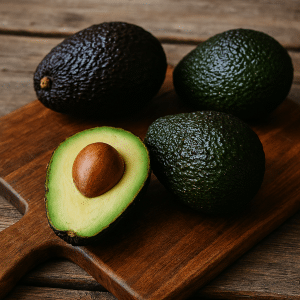Just stumbled across “arachidonic acid” in your latest fitness forum or nutrition group? You’re not alone. This omega-6 fatty acid is creating buzz among health enthusiasts for good reason.
Arachidonic acid (ARA) isn’t just another supplement trend. It’s a vital building block your body uses for brain function, muscle growth, and immune health.
Found naturally in your cell membranes, ARA plays important roles you probably never knew about.
But here’s what matters most: the foods you eat directly impact your ARA levels. Some pack serious amounts, while others barely register.
Ready to discover which arachidonic acid foods deserve a spot on your plate?
What Is Arachidonic Acid?

Arachidonic acid is a 20-carbon polyunsaturated fatty acid that belongs to the omega-6 family. Think of it as one of your body’s necessary building materials – like having the right grade of steel for construction.
Unique Structure
ARA has a unique structure with four double bonds, which gives it a flexible, almost hairpin-like shape. This flexibility is exactly what makes it so valuable in your cell membranes.
Unlike some nutrients your body can manufacture, you need to get ARA from food or convert it from other fatty acids (though this conversion is pretty inefficient).
Your Body’s ARA Hotspots
ARA concentrates where it’s needed most: up to 25% of brain fatty acids, 15-17% of skeletal muscle fatty acids, and high concentrations in immune cells, such as platelets and white blood cells.
Your cells tightly control ARA levels through a sophisticated recycling system that keeps it available when needed.
How It Differs from Other Fatty Acids
While omega-3s get most of the attention, ARA serves different but equally important functions.
Omega-3s are often anti-inflammatory, while ARA can both promote and resolve inflammation when needed. It’s not about good versus bad. It’s about having the right balance for optimal health.
Arachidonic Acid: Physiological Roles and Health Benefits

Your body treats arachidonic acid like premium fuel. Every cell membrane in your body contains ARA, giving cells the flexibility they need to function properly. Think of it as the oil that keeps your cellular machinery running smoothly.
Brain Power and Neural Function
ARA is critical for your brain’s performance. It makes up 15-20% of your brain’s fatty acids and supports neuron communication, helping form new memories and maintain cognitive function. Your brain actually consumes about 17.8 mg of ARA daily just to keep running optimally.
Muscle Function and Athletic Performance
Here’s where fitness fans get excited. ARA helps regulate muscle contractions and supports the signals that tell your muscles when to fire.
In skeletal muscle, ARA comprises 15-17% of total fatty acids, which explains why ARA supplementation has shown benefits for body composition, muscle function, and power output in strength-training individuals.
Immune System Support
ARA acts like a master switch for your immune responses. It helps your body fight off infections while also knowing when to dial down inflammation once the threat is gone.
This dual role makes it necessary for both protection and recovery.
Ion Channel Regulation
ARA directly affects the electrical activity of your cells by modulating ion channels in your brain, heart, and muscles.
This includes potassium, sodium, and calcium channels that control nerve impulses, muscle contractions, and hormone secretion, basically, the electrical system that keeps you functioning.
Recovery and Inflammation Resolution
When you’re injured or stressed, ARA metabolites kick into action. They help manage the inflammatory response needed for proper healing, then actively help resolve that inflammation when it’s time to recover.
This isn’t just passive healing, it’s an active, programmed response.
Mood and Energy Balance
Through the endocannabinoid system, ARA derivatives help regulate mood, pain perception, stress responses, and energy balance. These compounds are critically important for brain reward signaling and motivational processes.
Source: Arachidonic acid: Physiological roles and potential health benefits – A review – Hatem Tallima, Rashika El Ridi, National Library of Medicine
Implications and Considerations

Let’s talk balance. ARA isn’t inherently good or bad. It’s all about context and recognizing its necessary role, as well as finding the right balance for your body. Like many nutrients, context matters more than absolute quantities.
- The Omega Balance: Here’s where things get interesting. ARA is an omega-6 fatty acid, and it needs to be balanced with omega-3 fatty acids. The typical Western diet often tips too heavily toward omega-6 fatty acids, which can promote inflammation when omega-3 fatty acids are low.
- The Essential Factor: Your body can’t make enough ARA on its own, so you need dietary sources. It’s essential for normal growth and development.
- Individual Responses: Some people handle higher ARA intake just fine, while others might experience increased inflammation. Your genetics, overall diet, and health status all play roles.
- Infant Development: Babies need ARA for proper brain and vision development. That’s why it’s added to many infant formulas.
- Athletic Performance: Some research suggests that optimal ARA levels may support muscle building and recovery; however, further studies are needed.
Foods High in Arachidonic Acid
Ready for the practical stuff? Here’s where you’ll find the most arachidonic acid in your diet, based on national dietary data.
Top Arachidonic Acid Sources (Ranked by Contribution)

According to the NCI report analyzing actual American diets, here are the foods that contribute the most arachidonic acid:
-
Chicken and Chicken Mixed Dishes (26.9%) – The #1 source by far. This includes grilled chicken, stir-fries, casseroles, and dishes from restaurants. Dark meat contains more ARA than white meat, making thighs and drumsticks particularly rich sources.
-
Eggs and Egg Mixed Dishes (17.8%) – The Second biggest contributor. The yolks pack the most ARA, so whole eggs beat egg whites every time. Scrambled eggs, omelets, and baked goods containing eggs all count toward your intake.
-
Beef and Beef Mixed Dishes (7.3%) – Solid third place. Think steaks, roasts, beef stews, and meat sauces. Grass-fed beef typically contains higher ARA levels than grain-fed, giving you more bang for your buck.
-
Sausage, Franks, Bacon, and Ribs (6.7%) – Processed meats pack ARA. These foods are concentrated sources because they often combine multiple animal proteins and fats. Weekend barbecues suddenly look more nutritionally interesting.
-
Other Fish and Fish Mixed Dishes (5.8%) – Surprising, fish contribution. While not as high as meat sources, salmon, tuna, and shellfish still deliver meaningful amounts. Fish dishes, such as sushi, fish tacos, and seafood pasta, can add up quickly.
-
Burgers (4.6%) – Ground beef delivers. The grinding process breaks down cell membranes, potentially making ARA more available. Plus, burgers often include cheese and other ARA-containing ingredients.
-
Cold Cuts (3.3%) – Deli meats add up. Turkey, ham, roast beef, and salami might seem like small portions, but regular sandwich consumption makes them a notable source in most diets.
-
Pork and Pork Mixed Dishes (3.1%) – Another solid source. Pork chops, bacon, ham, and dishes like pork fried rice contribute steadily. The fat content in pork makes it a reliable ARA provider.
What This Means for You: Chicken dominates as the top ARA source, followed by eggs as your second-best option, and seafood as another valuable source. Mixed dishes, such as casseroles and stir-fries, are particularly effective since they combine multiple ARA-rich ingredients in one meal.
Focus on these protein sources to improve your ARA intake through everyday food choices.
Source: National Cancer Institute – “Identification of top food sources of various dietary components”
Plant Sources (The Supporting Cast)

Plant foods don’t directly contain much ARA, but some provide linoleic acid, which your body can convert to ARA (though not very efficiently).
- Nuts and Seeds: Especially peanuts and sunflower seeds
- Vegetable Oils: Corn, soybean, and safflower oils
- Avocados: Small amounts, but worth mentioning
The Reality Check: If you’re vegetarian or vegan, getting adequate ARA can be challenging since your body’s conversion rate from plant sources is pretty low.
How to Include Arachidonic Acid in Your Diet

Getting the right amount of ARA doesn’t require complicated calculations or drastic diet overhauls. Focus on balanced, whole-food choices that naturally provide what your body needs while maintaining the important fatty acid ratio.
Your ARA Action Plan
Follow these four straightforward principles to improve your ARA intake without overthinking it. These guidelines will help you naturally balance your ARA and omega fatty acids through everyday food choices.
- Include quality animal proteins 3-4 times per week: Chicken thighs, lean beef, or pork provide direct ARA without excess. Rotate your protein sources rather than eating the same one daily.
- Balance every high-ARA meal with omega-3s: Pair that chicken dinner with a side of salmon, or follow your beef lunch with walnuts as an afternoon snack. This immediate balancing helps control inflammation.
- Limit processed vegetable oils: Skip corn, soybean, and safflower oils in cooking. Use olive oil, coconut oil, or avocado oil instead. Check labels; many packaged foods are loaded with omega-6 oils.
- Prioritize whole foods over packaged options: Fresh meats, eggs, and nuts deliver ARA along with other beneficial nutrients, while processed foods often provide poor-quality fats with inflammatory additives.
Practical Daily Meals
Here’s how these principles translate into actual meals you can prepare today. These examples show what a balanced ARA intake looks like on your plate.
- Breakfast: Scrambled eggs with spinach, cooked in olive oil, served with half an avocado
- Lunch: Grilled chicken salad with mixed greens, cherry tomatoes, and a handful of walnuts
- Dinner: Baked salmon with roasted vegetables, or lean beef stir-fry with broccoli
- Snacks: Small portions of mixed nuts (almonds, walnuts, pecans) or hard-boiled eggs
Supplementation Considerations: Most people get enough ARA from food. Supplements may be beneficial for infants on formula, individuals with specific health conditions, or those following very restrictive diets. Always consult a healthcare provider first.
Key Takeaways and Your Next Steps
Arachidonic acid isn’t just another nutrition buzzword. It’s a legitimate player in your health game. Your body needs it for brain function, muscle performance, and immune health.
The key is balance, not extremes. Most people following a varied diet will naturally get adequate ARA.
If you’re new to tracking your fatty acid intake, start simple: add some quality protein sources to your meals and pay attention to how you feel. Your body will tell you what works.
Ready to improve your nutrition? Consider consulting with a registered dietitian who can help you create a personalized plan.
Have you noticed any benefits from including more ARA-rich foods in your diet? Drop a comment below and share your thoughts, we’d love to hear from the community about what’s working for you!
Frequently Asked Questions
Can Vegetarians Get Enough Arachidonic Acid?
Plant-based diets typically provide lower ARA levels, so vegetarians might need to be more intentional about including nuts, seeds, and plant oils while considering supplementation.
How Does Arachidonic Acid Affect Brain Health?
ARA supports neuron function, memory formation, and overall brain performance. It’s particularly important during development and aging.
Should I Take an Arachidonic Acid Supplement?
Most people who eat a varied diet don’t need supplements. They’re mainly useful for infants, people with specific health conditions, or those on very restricted diets.













